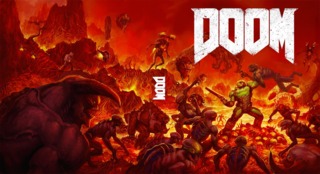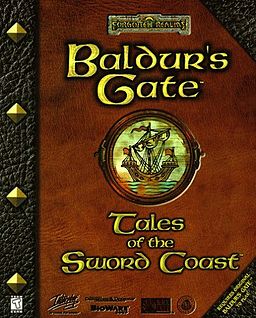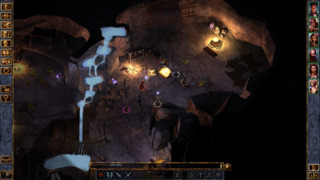You, Me, and CRPG (Part 1: Introduction and Baldur's Gate)
By ArbitraryWater 15 Comments

Oh hi there Giant Bomb and friends, how is it going? It’s going okay right now, thanks for asking. I was working on a blog about Dark Souls III when I realized that, honestly, I didn’t have much to say about that game that hadn’t been said elsewhere. It’s a really good game that becomes better as it goes on, but I think its nature as a very reflexive, self-referential conclusion to the Dark Souls trilogy prevents me from ranking it as high as I would otherwise have. For those, and many other reasons, it sits firmly in the middle of my extremely legitimate Souls tier list, with the secret curve being that I think they’re all great games. Even the worst Souls game in the series is still better than Salt and Sanctuary (which I thought was alright) and Lords of the Fallen (which I only played a few hours of before going “nah, I’m good”). I also played that hot new Doom game that all the kids are talking about now and it’s kind of amazing? Like, I got the platinum trophy for it, which admittedly isn’t super hard as far as platinum trophies are concerned, but if you have any sort of affinity for video game-ass video games and shooters of the first-person variety, the single player campaign for that game is more than worth your time.
But I digress. I’ve been writing blogs “for fun” in this community long enough to know when the motivation isn’t there, and I haven’t had a ton of motivation to write much of anything the past few months. It turns out the game that motivated me to actually write something was Baldur’s Gate, which I finished another playthrough of in order to import a character directly into the new Siege of Dragonspear expansion. The discussion around that game has been sufficiently poisoned by angry internet folk complaining about “SJWs ruining muh video games” for me to get much out of it, and in any case it was always going to be a Thief reboot/The Evil Within scenario where I had to play it for myself regardless of outside opinions. Instead of writing about how much I like Baldur’s Gate for a third time, I figure it would be a fun idea to write about all of the old-ass CRPGs I’ve encountered along the road in a way that acts as both a primer for the game and as a summary of my thoughts about it. The intent is to make this into a series of some sort and cover some other classics of the genre, like Fallout or whatever, but since Baldur’s Gate is so fresh in my mind, I might as well start with that first. I imagine I’ll get to the rest of the Infinity Engine games in due time, though I guess I should wait and see if this actually turns out to be a series or not.
The Infinity Engine (not to be confused with the EA football physics engine of the same name) is responsible for 5 of the best Computer Role-Playing Games ever made. Baldur’s Gate 1 and 2, Icewind Dale 1 and 2, and Planescape: Torment. You’ve probably read some of my ravings about these games before, given that I played through most of them for the first time recently enough to have blogs on the site. All of them are Dungeons and Dragons RPGs (mostly using AD&D 2nd Edition, though Icewind Dale 2 uses D&D 3.0) focused around large parties of characters (up to 6) with real time combat that you can pause at any time to issue commands to your characters. I won’t get into the nitty-gritty of the mechanics because that would take me all day, and because I assume anyone who cares about reading this at least has a baseline understanding of how Dungeons and Dragons works. If you don’t… well, all you really need to know is that a lower THAC0 is better, only Humans can be Paladins, a Fighter/Mage/Thief splits their experience gain between the three classes, and 18/00 strength is way better than 18/01 strength. The esoteric and convoluted rules that govern AD&D are half the story though, because it turns out that translating Dungeons and Dragons to an isometric perspective real-time with pause format brings its own weird quirks to the table. All of these games, with the possible exception of Planescape, demand a heavy amount of micromanagement when it comes to combat, which can sometimes veer dangerously close to the realm of “chaotic mess”. The character pathing tends to get a bit messy itself, and it’s more than possible for one of your party members to accidentally get separated from the rest of the group when crossing large city maps or cramped dungeons. Detecting traps can be and usually is a pain in the ass. Inventory works on both a slot and encumbrance-based system, which really speaks to the nature of what these games actually are. Over the years I’ve answered a handful of threads asking “Where is a great place to get into old CRPGs?” and honestly I don’t think there’s a great answer to that question. All of these games have their own caveats, their own special brand of old-school bullshit that the player needs to overcome or accept to enjoy because these games were made for grognards by grognards 15+ years ago. Despite being a little young to have played any of these when they were new, my tolerance for that stuff is pretty high and I’ve been playing them long enough that I can’t fully project what might be a hang up for someone who has never played one of these sorts of games before.
Baldur’s Gate

I’ve always thought it a little sad that Baldur’s Gate has the misfortune of sitting in the shadow of its legendary successor, because it’s a great game in its own right, if perhaps the roughest of the Infinity Engine to just sit down and try to start in 2016. The first half, if not the first two-thirds of Baldur’s Gate involves a lot of wandering around the wilderness of The Sword Coast (picking up quests and having encounters with monsters or weird NPCs) in a way one could generously describe as “deliberate.” While the game’s main quest (involving your rag-tag group of adventurers investigating an iron shortage and greater threats to the Forgotten Realms while also discovering your character’s heritage) is straightforward and rarely off the beaten path, low-level D&D is sufficiently deadly that you probably don’t want to touch the Nashkel mines until everyone is at least level 2, if not 3. Thus, you gotta explore and adventure and stuff. There’s a certain lackadaisical pace to the whole thing that I find pleasant when combined with the game’s “generic D&D” tone and haunting soundtrack, and it’s important to note how ambitious and important Baldur’s Gate was at the time, encompassing a more whole and accurate simulacrum of the tabletop experience than the games that came before it. But... at its worst the early hours of Baldur’s Gate involve a lot of quicksave abuse, a lot of shuffling party members in and out looking for ones with good stats and a lot of giant wilderness maps with one or two interesting things. You don’t have to go as far as I did in my last playthrough and do almost everything, in fact you could probably ignore a lot of stuff and still turn out alright. The game picks up more around the halfway mark, and once you get to the titular city itself it’s a lot easier to find quests that are interesting, even if the NPCs you can recruit at that point almost seem like an insult (I’d love to find someone who used Tiax and Alora legitimately).
One thing that is probably worth expanding upon is that Baldur’s Gate 1 is far less interested in character development or area-specific vignettes than you’d expect from a Bioware game. There are a lot of NPCs to recruit into your party of 6, most of whom don’t talk much outside of their recruitment speeches and their various barks when you select them, which makes it super weird when they will go out of their way to talk in a quest or a quest will directly acknowledge them. There are some roots of what is to come, like special NPC banters when you have certain combinations of party members, though most of them probably won’t show up unless you’re really committed to having two characters who hate each other in the same group. The writing similarly goes for a “Generic Forgotten Realms Adventure” feel, with an almost refreshing lack of pretension towards “Choices and Consequences” compared to the modern obsession for them. You’re playing a D&D adventure. You do D&D adventure things. It doesn’t take itself too seriously, but it’s not all goofs all the time like Divinity. I find this low-key, swashbuckling tone a nice change of pace from the self-serious, player character-focused writing of more recent RPGs, but I could also totally understand if someone found it boring. Luckily for that hypothetical person, that's what BG II is for.

That brings me to the game’s expansion, Tales of the Sword Coast, which I had never actually played through until this last playthrough. TotSC (to clumsily abbreviate it) adds a handful of high-level quests to the game (bringing up the experience cap to allow for another level or two for most classes), all of which are accessed or started through the small town of Ulgoth’s Beard located at the top of the world map. In a lot of ways, the Durlag’s Tower mega-dungeon (a tower with a 6-floor trap and puzzle-filled monstrosity of a basement that served as the inspiration for the even bigger Watcher’s Keep in BG II) and the Werewolf Island quest feel like stepping stones to the more complex writing and dungeon design of Baldur’s Gate II, even if Durlag’s Tower sometimes feels like a slog and the Werewolf Island quest is brought down by enemies who can only be damaged by +3 weapons or higher (which are more than a little rare in BG1). At most, this stuff is like an extra 12-15 hours, though I was skimming a guide and it didn't take me quite as long.

Last, I would be remiss if I didn’t mention the Enhanced Edition. 3 of the 5 Infinity Engine games have gotten the “Enhanced Edition” treatment from Beamdog (a small studio that was founded by ex-Bioware employees) all of which have added a bunch of engine-level improvements, bug-fixes and additional content, which sounds alright on paper but is less exciting in reality. Thanks to more than a decade of fan-mods, it’s quite possible to play Baldur’s Gate 1 with many of the improvements of its sequel, like class kits, higher resolutions, pressing the TAB key to highlight interactable objects and so on and so forth. The Enhanced Editions go a step further than the likes of the Baldur’s Gate TuTu or Baldur’s Gate Trilogy mods, with stuff like a quick loot bar and a couple of other small but appreciated tweaks, though from the outside I always thought they seemed unnecessary at best. Now that you don’t have a choice and have to buy the vanilla and Enhanced versions together (a dickish move on Hasbro’s part that probably makes sense from a brand confusion standpoint) it’s probably the best way to play the game and save yourself the hour or so it would take to track down and install a bunch of mods. It’s not just all bugfixes though, there’s also some dire new content which is thankfully ignorable. To put it lightly, the new NPCs added in the Enhanced Edition stick out in the same way the added effects in the Star Wars Special Editions stick out, and not just because the voice acting was clearly recorded at a higher audio quality. While I only kept the Wild Mage Neera in my party (Rasaad being a monk in a game where monks are hot garbage until they reach higher levels and Dorn being evil as evil can be even if he seems like the most useful of the three. Neera's wild magic mostly just means that sometimes her spells don't work and it sucks) their introductions, their mini-quests, and the fact that you can romance them make them all clashes with the tone of Baldur’s Gate 1 that I mentioned earlier. It doesn’t help that the new areas made specifically for their quests look worse than the rest of the game, or that the actual quality of the writing sometimes dips into amateurish territory. They’re easily ignored once you get past their introductions, but… yeah, they’re basically the equivalent of that deleted scene where Han Solo steps on Jabba’s tail. Not “Han Shot First” or “Ghost Hayden Christensen” bad, but my hope is that they’re a little more at home and better written when I encounter them in Baldur’s Gate II Enhanced Edition. Oh, and there’s also an arena mini-campaign called The Black Pits that seems like it exists mostly because the developer didn’t want to make any more new art assets, and the original CG cutscenes are replaced with marginally worse looking hand-drawn/slightly animated ones (a mistake they did not repeat in BG2 EE).
Final Verdict in bullet points:
Baldur’s Gate is a great game, but it’s hard to recommend to someone who hasn’t played a game like it before.
A lot of the game involves walking around wilderness areas. I’m into that.
The game goes for a deliberate “Generic D&D” tone and feel alongside its low-level adventuring.
The content in Tales from the Sword Coast is alright, but mostly interesting in the context of how it reflects the sequel.
The Enhanced Edition is okay, but the new NPCs feel out of place and are a little cringe-worthy.
I can’t comment on the new Siege of Dragonspear expansion yet, but I’m attempting to play through it right now assuming my stupid computer cooperates. If I do get through it, you can almost certainly expect a review or blog.
And that’s a wrap, I think. Don’t worry, I imagine I’ll cover more than one game in subsequent blogs now that the introduction is out of the way, but I hope this has been… enlightening? Useful? Entertaining? If you have any suggestions for stuff you’d like to see covered, feel free to ask. I’ve played a lot of RPGs. Maybe I’ll give you one of those GOG gift codes I have lying around for no good reason. Maybe I'll also do that Kingdom Hearts blog I've been writing in my head for the last 3 months.
